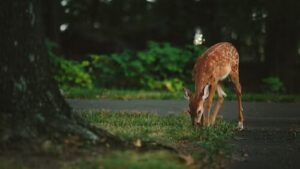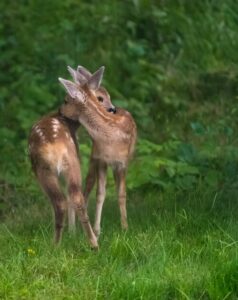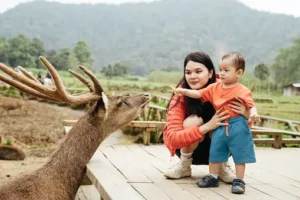Introduction And Facts About Deer
Facts about deer, Deer is elegant and adaptable creatures belonging to the family Cervidae, inhabit a diverse range of ecosystems around the world. These herbivorous mammals exhibit a remarkable array of adaptations that have allowed them to thrive in various environments.
Characterized by their graceful movements and distinctive antlers, male deer use these bony appendages for territorial displays and the competition for mates during the rutting season. While males boast antlers, females, known as does, lack these adornments.
With keen senses of smell and hearing, deer navigate their surroundings with vigilance, always attuned to potential threats from predators like wolves, cougars, and bears. Their natural camouflage and exceptional agility serve as defenses, allowing them to vanish into dense vegetation or bound over obstacles in their path.
In tune with nature’s rhythm, deer are often crepuscular, emerging at dawn and dusk to graze on vegetation and browse for sustenance. Beyond their ecological role, deer have woven themselves into the tapestry of human culture, holding symbolic significance and sustaining traditional practices such as hunting.
However, as human habitats encroach upon theirs, managing the delicate balance between coexistence and conflict becomes paramount, emphasizing the need for responsible conservation efforts to safeguard the enduring legacy of these enchanting and iconic creatures.

30 Amazing Facts About Deer And Types!
- Diverse Species: Deer belong to the family Cervidae, and there are over 90 species of deer found across the world.
- Antlers and Horns: Male deer (bucks) typically have antlers, which are grown and shed annually, while females (does) lack antlers. Antlers are made of bone and are used for various purposes, including dominance displays and attracting mates. In contrast, horns are found in some other ungulate species and are permanent structures made of keratin.
- Velvet: Antlers grow covered in a soft, vascular skin called velvet, which provides nutrients and aids in their growth. Once fully developed, the velvet is shed or rubbed off.
- Antler Shedding: Antler shedding is influenced by factors like age, genetics, nutrition, and seasonal changes in hormone levels.
- Deer Species Size: Deer species range in size from the tiny Pudu, which stands about a foot tall, to the massive moose, which can weigh over 1,000 kg.
- Herbivores: Deer are herbivores, primarily feeding on vegetation such as grasses, leaves, twigs, and fruits.
- Ruminants: Deer are ruminants, possessing a specialized stomach with four compartments that aid in digestion. They regurgitate and re-chew their food to extract maximum nutrients.
- Hooves: Deer have cloven hooves, which means their hooves are split into two distinct sections.
- Excellent Jumpers: Deer are agile and skilled jumpers, capable of clearing obstacles up to 10 feet high.
- Migratory Behavior: Some deer species, like the mule deer, engage in seasonal migrations to find food and escape harsh weather conditions.
- Camouflage: Deer have evolved natural camouflage to blend into their surroundings, aiding in avoiding predators.
- Predators: Natural predators of deer include wolves, cougars, bears, and sometimes even alligators.
- Territorial Behavior: Male deer often establish territories during the breeding season, defending them against other males.
- Scent Marking: Deer communicate using scent marking, such as rubbing their antlers on trees or using scent glands on their legs and face.
- Mating Rituals: During the rut (mating season), male deer engage in elaborate displays of dominance, including vocalizations, posturing, and antler clashes.
- Social Structure: Deer are often seen in small family groups, with does and their fawns forming the core unit.
- Monogamy: Some deer species exhibit monogamous behavior, with males and females forming long-term pair bonds.
- Nocturnal Activity: Many deer species are more active during dawn and dusk, which helps them avoid predators.
- Sense of Smell: Deer have an excellent sense of smell, which they use to detect danger and locate food.
- Running Speed: Deer are fast runners, with some species reaching speeds of up to 40-50 mph (64-80 km/h).
- Vision: Deer have dichromatic color vision, which means they perceive colors differently from humans.
- Home Range: Deer often have defined home ranges they frequent for food, water, and shelter.
- Sound Communication: Deer communicate through a variety of vocalizations, including grunts, bleats, and snorts.
- Longevity: In the wild, the lifespan of deer varies depending on species, habitat, and other factors, but it generally ranges from 4 to 15 years.
- Adaptation to Cold: Species living in colder climates, like the reindeer (caribou), have adaptations such as a thick winter coat and specialized hooves to help them navigate snow.
- Tick and Parasite Control: Some deer species groom themselves and use areas known as “deer yards” to gather, which helps reduce tick and parasite loads.
- Cultural Significance: Deer have held cultural and symbolic significance in various societies, often representing traits like grace, fertility, and spirituality.
- Economic Impact: Deer hunting is a significant economic activity in many regions, providing both subsistence and recreational opportunities.
- Conservation Concerns: Some deer species, like the white-tailed deer, have experienced population increases and overbrowning due to habitat changes and the absence of natural predators.
- Human Interaction: Deer can become habituated to humans, which can lead to conflicts, especially in urban areas, where they may damage gardens or cause vehicle accidents.
The 20 Most Amazing Birds In Virginia! (2023)
Behavior And Facts About Deer:

Deer exhibit a range of behaviors intricately linked to their survival and social interactions. These herbivores are skilled foragers, adept at selecting and consuming a variety of vegetation. They often form small family groups led by a dominant female, where does and their fawns share a close bond.
Male deer engage in ritualistic displays of dominance during the mating season, using antler clashes and vocalizations to establish mating rights. Vigilant and attuned to their environment, deer employ their keen sense of smell and acute hearing to detect predators and communicate with one another.
Their crepuscular activity pattern, with heightened movement during dawn and dusk, aids in avoiding threats and conserving energy. Seasonal migrations, particularly among certain species, further exemplify their adaptable nature, as they seek optimal food sources and suitable habitats to ensure their survival.
Diet of Deer:

Deer are beasties with a different and adaptable diet. Their primary food consists of foliage similar as meadows, leaves, outgrowths, and fruits. During the warmer months, they consume a variety of shops, including tender shoots and leaves.
As seasons change, deer acclimate their diet to the available food sources, frequently shifting from browse to further stringy foods like woody shops in colder months. Their technical stomach, multi-chambered organ, aids in breaking down factory matter through a process of regurgitation and re-chewing. This allows them to prize maximum nutrients from their factory- grounded diet.
Types And Facts About Deer:
- White-Tailed Deer : One of the most widespread deer species in North America, known for their distinctive white tail and adaptability to various habitats.
- Mule Deer : Native to western North America, they have large ears and are named for their distinctive jumping style, similar to a mule.
- Red Deer : Found in Europe, Asia, and North America, they are one of the largest deer species, often with impressive antlers.
- Sika Deer : Native to East Asia, they come in various color morphs and are known for their distinct vocalizations.
- Fallow Deer : Originally from Europe, they are now found in various parts of the world and have a unique coat pattern.
- Roe Deer : Native to Europe and Asia, they are relatively small and have distinctive white rump patches.
- Elk : Also known as wapiti, they are one of the largest deer species and inhabit North America and parts of Asia.
- Sambar Deer : Native to Southeast Asia and parts of South Asia, they are known for their large size and impressive antlers.
- Axis Deer : Originally from India, they have been introduced to various parts of the world and have striking white spots on their coat.
- Musk Deer : Found in Asia, these small deer are known for their musk-producing glands and lack of antlers.
- Reindeer : Also known as caribou in North America, they inhabit Arctic and subarctic regions and have unique adaptations for cold environments.
- Pudu Deer : Native to South America, they are among the smallest deer species, with a height of about a foot.
- Water Deer : Native to East Asia, they lack antlers and are well adapted to aquatic environments.
Deer Reproduction and Mating Rituals:

Deer reproduction is a fascinating process accompanied by intricate mating rituals, most prominently observed during the rutting season. This annual spectacle involves both behavioral displays and physiological changes that play a crucial role in perpetuating deer populations.
The rutting season, also known as the mating season, typically occurs in the fall for many deer species. During this time, male deer, or bucks, engage in elaborate displays of dominance to establish mating rights with receptive females, or does. These displays involve a combination of visual cues, vocalizations, and physical contests.
One of the most iconic aspects of the rut is the clash of antlers between competing bucks. These battles determine the hierarchy within the population and provide a means for dominant bucks to secure access to mates. The sound of antlers locking and the sight of bucks locked in combat are powerful indicators of the intense competition for mating opportunities.
Vocalizations also play a significant role in deer communication during the rut. Bucks emit deep grunts and roars to signal their presence and dominance to both potential mates and rival males. These vocalizations convey information about a buck’s size, strength, and readiness to mate.
As the rutting season progresses, hormonal changes trigger physiological transformations in both male and female deer. Bucks experience an increase in testosterone levels, leading to the growth and hardening of their antlers. This preparation aids them in battles for dominance and impressing potential mates.
For does, the rut signals the optimal time for reproduction. They enter estrus, a period of heightened receptivity, usually lasting about 24 to 48 hours. Bucks use their acute sense of smell to detect pheromones released by receptive does, allowing them to locate potential mates.
Ultimately, the rutting season is a culmination of evolved behaviors and adaptations that ensure the survival of deer populations. It showcases the intricate interplay between physical prowess, sensory perception, and hormonal shifts, all contributing to the continuation of this captivating natural cycle.
Why Do Owls Hoot? How, When, And Where, 4 Amazing Facts
Human Interaction with Deer:

Human interaction with deer is a multifaceted relationship that encompasses various aspects, including conservation, cultural significance, and potential conflicts. Deer hold cultural and symbolic value in many societies, often representing traits like grace, gentleness, and spirituality. However, these animals also play a vital role in ecosystems, influencing plant communities through their browsing habits.
Deer populations are subject to human influence through habitat alteration and fragmentation, leading to increased encounters in urban and suburban areas. While these interactions can be enchanting, they also pose challenges. Deer-vehicle collisions are a safety concern, causing injuries and fatalities for both humans and deer.
Moreover, deer browsing can impact agricultural and ornamental plants, leading to economic losses. To address these concerns, wildlife management strategies have emerged, aiming to balance deer populations and mitigate conflicts. These strategies include regulated hunting to control population sizes, as well as the implementation of fencing and repellents to reduce crop and property damage.
Conservation efforts also play a crucial role, particularly in protecting deer habitats and maintaining healthy ecosystems. Educating the public about responsible wildlife interactions and the importance of preserving natural habitats is essential for fostering coexistence.
In conclusion, human interaction with deer encompasses both positive cultural connections and challenges associated with their expanding presence in human-dominated landscapes. Balancing these interactions requires a thoughtful approach that considers the ecological role of deer, human safety, and the preservation of both wildlife and human interests.
Diversity of Deer Species Worldwide:
The global landscape is adorned with a remarkable diversity of deer species, each uniquely adapted to its specific habitat and ecological niche. Ranging from the dense forests of North America to the vast steppes of Asia and the grasslands of Africa, deer have evolved diverse characteristics that enable them to thrive in a variety of environments.
From the iconic whitetail deer of North America to the elegant red deer of Europe, these species exhibit a wide array of sizes, coat colors, and antler structures. Some, like the tiny pudu of South America, are diminutive in size, while others, such as the mighty moose of North America and Eurasia, command attention with their imposing stature.
Antlers, a defining feature of most male deer, come in an assortment of shapes and sizes. The intricate antler structures of species like the elk and the reindeer serve multiple purposes, including mating displays and competition for mates. Female deer, known as does, lack antlers but possess their own unique adaptations to suit their reproductive roles.
Deer species have also adapted to diverse diets, including grazing on grasses, browsing on leaves and shrubs, or a combination of both. This dietary diversity reflects their ability to exploit available food sources and inhabit a wide range of habitats.
Intriguingly, many deer species play vital roles in maintaining ecosystem dynamics through their selective browsing, seed dispersal, and interactions with predators and other species. The conservation of this global deer diversity is essential not only for preserving these captivating creatures but also for ensuring the health and balance of the ecosystems they inhabit.
Predators and Natural Threats to Deer Populations:
Deer populations face a range of predators and natural threats that influence their survival and distribution. Apex predators like wolves, cougars, and bears are significant deer predators, preying on both young and weak individuals. Predation pressure can regulate deer populations and help maintain ecosystem balance.
Human-induced factors, such as habitat loss and fragmentation, also impact deer populations by reducing their suitable habitats and increasing their vulnerability to predators. Additionally, diseases like chronic wasting disease (CWD) and parasites like ticks can weaken and even decimate deer populations, posing further threats.
Climate-related changes, including severe weather events and shifts in vegetation patterns, can affect deer habitats and foraging opportunities. These natural threats collectively interact with human activities and can lead to fluctuations in deer populations, emphasizing the need for holistic wildlife management approaches that consider both predator-prey dynamics and human impacts.
Diseases Affecting Deer:
Diseases exert a significant impact on deer populations worldwide. Chronic Wasting Disease (CWD), a transmissible neurological disorder, has emerged as a major concern, leading to widespread deer fatalities in North America and other regions. Epizootic Hemorrhagic Disease (EHD) and Bluetongue Virus (BTV) also pose threats, causing fever, hemorrhaging, and death in deer.
Tick-borne illnesses like Lyme disease and Anaplasmosis affect both deer and humans, with deer acting as hosts for disease-carrying ticks. These diseases can lead to reduced survival rates and compromised health in deer populations. Furthermore, bovine tuberculosis can be transmitted between deer and livestock, impacting both agricultural and wildlife health.
Disease management and monitoring are vital for safeguarding deer populations. Strategies such as surveillance, population control, and research into disease-resistant traits aim to mitigate disease impacts and preserve healthy deer populations in their ecosystems.
Conclusion:
In conclusion, deer stand as remarkable and diverse creatures with a profound impact on ecosystems and human culture. From their elegant presence in the wild to their symbolic significance in societies, deer capture our imagination. However, their existence is entwined with complex challenges, including human interactions, habitat preservation, disease management, and predator-prey dynamics. By fostering a harmonious coexistence, implementing effective conservation measures, and understanding their vital role in the natural world, we can ensure that deer continue to inspire and thrive, enriching the tapestry of life on our planet.
FAQ’s:
What are some fascinating facts about deer behavior?
Deer are known for their intriguing behaviors. They exhibit a phenomenon called “rutting,” where males (bucks) engage in fierce competitions for mating rights. During this time, bucks use their antlers to spar with rivals. Additionally, deer are excellent swimmers and can cover long distances in water to escape predators or search for food.
How many different types of deer are there?
There are over 90 species of deer worldwide, each adapted to diverse habitats. Some well-known types include the white-tailed deer, moose, elk, reindeer, and mule deer. These species vary in size, appearance, and habitat preferences, showcasing the incredible diversity within the deer family.
What is unique about deer antlers?
Deer are the only group of animals that possess branched antlers. Antlers are shed and regrown annually, serving various purposes such as attracting mates and establishing dominance. Antler size and complexity often indicate a buck’s age and status within the population.
How do deer contribute to their ecosystems?
They shape plant communities through their feeding habits, which can influence forest composition and promote biodiversity. Additionally, deer serve as prey for predators like wolves and cougars, helping to sustain predator populations.
Are there any conservation concerns related to deer species?
Yes, several deer species face conservation challenges. Chronic Wasting Disease (CWD) poses a significant threat to deer populations, as it spreads among individuals and can lead to population declines. Habitat loss due to urbanization and fragmentation also impacts deer habitats and migration routes, necessitating active conservation efforts to ensure their survival.


